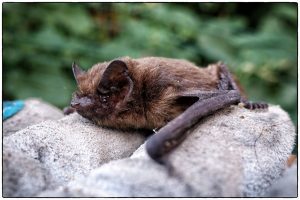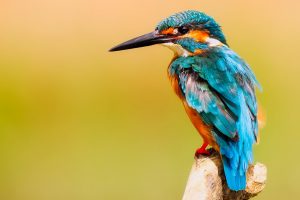
Bats, newts, voles, swans and a kingfisher are just some of the wildlife that can be spotted night and day at Salford’s Peel Park, say rangers who lead walks around the revamped open space.
Over Easter, Salford University’s Wildlife society hosted a joint event with the Peel Park rangers for students and the public to explore the different wildlife from at dusk.
Peel Park ranger Jessica Britch explained that bats are just one of the highlights. She said: “We do quite well for bats here. So, in the evening you can see Pipistrelle bats and Daubenton’s bats flying over the water.

A common pipistrelle bat. (Image: Flickr.com)
“In the day, if you go down to the river you can see a lot of our water birds. We’ve got Canada geese and swans that come here. We’ve got a kingfisher that lives nearby. If you’re lucky enough and go and stand near the river, you will see that flash of turquoise or sometimes he goes and sits on the bank as well.”

Jessica believes that spotting local wildlife is the best place to start. She said: “There are lots of different ways in which you can get involved with looking for wildlife in your area.
“However, going and doing it on your doorstep is one of the best things you can do really.”
The Bioblitz event, during which members of the public help experts with wildlife surveys, was co-hosted by the Wildlife Society, a group University of Salford students.
Jessica added: “Here at Peel Park, we’re lucky enough to have the University on our doorstep so all those students can come across and local families from the area as well.”
“We did Bioblitz training last weekend where we recorded over 100 species and tonight we’ve been getting a lot of different things.
“We’ve had two different kinds of bats, we’ve had five different kinds of amphibian. So, all these things are very local to where people are living, and that’s probably the best place to start when you’re looking for wildlife.
“We had three different kinds of newts, which were great crested newt, which are a protected species. We had palmate newt, smooth newt, toads and frogs.”

If that wasn’t enough, the rare ducks which fly to Salford during the breeding season can also be sighted on the river.
She said: “This stretch of the River Irwell is actually cited as biological importance and that’s because of the over-wintering water fail. So, we’ve got two ducks that come here over winter which are the golden eye and the tufted ducks.
“They fly here from Scandinavia and actually breed here, so that’s why it’s a site of biological importance.”
Salford Wildlife president, Laura Clavin, said of the Bioblitz event: “We had quite a big turnout. A lot of them were students from MMU, University of Manchester and Salford which was good them coming together. We educated them on Salford Rangers and the volunteering. So we opened the doors to them as well.”
Joseph Palframan, one of the park rangers at the Wetlands, says the bats are one of the best things to see at Peel Park, if you can find them.
“There’s three types of pipistrelle bats. There’s the soft soprano pipistrelle, common pipistrelle. They’re the ones people get around their gardens mostly. We also get them by the river and just over the water there. And we get daubenton’s bats.”
Mr Palframan explained how bats hibernate and live in small, dark places, but April is one of the best times of year to see them. He said: “All the bats in this country feed on insects. That’s related to temperature and that’s part of the reason why they hibernate as well.
“As it gets colder, there’s less insects around, so they hibernate.
“We get the dark pipistrelle bats over by the Meadows and often by buildings as well. They will be using the buildings to get a roosting and also trees that have gone over, like a little hole in the tree.
“They will be feeding on lots of insects and moths around at this time of night. They often come out around sunset and will be feeding all night. They often come out around March until around September, October. Now is a good time to see them.
“We had a nice calm night tonight, not much wind so it’s an ideal time to find them.”
Mr Palframan urged residents to create more wildlife habitats in their own gardens.
He said: “If they’ve got any small garden areas, anything from putting up nesting boxes so they can house the birds and bats, leaving some of your garden a bit untidy as well.
“People often think neat and tidy but actually wildlife needs a bit of areas that have been left alone. It’s for attracting insects in your garden, the birds and bats. You want some plants that will attract the insects and also a variety that have berries on them. The birds like berries to feed on.”
Image courtesy of Pixabay
Main image















Recent Comments